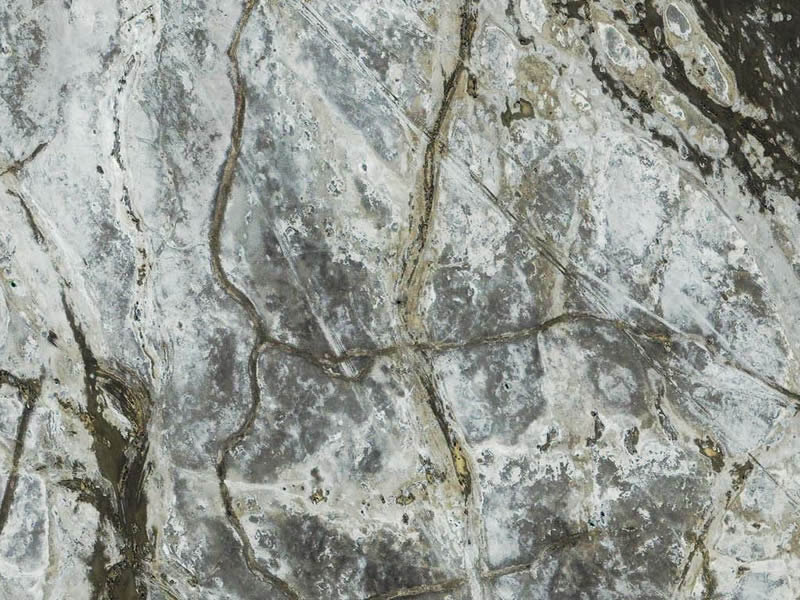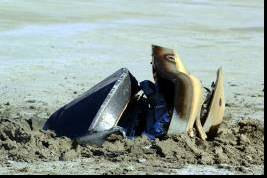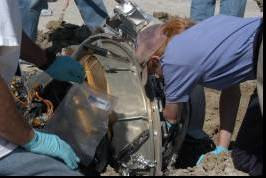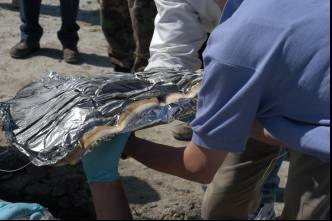Capsule Recovery and Operations
- Introduction
- Recovery and Geologic Setting
- Collector Recovery
- Contamination Concerns
- Conclusion
- References
Introduction
The Genesis mission returned to Earth on September 8, 2004 after a nearly flawless three-year mission to collect solar matter. The intent was to deploy a drogue chute and parafoil high over the Utah desert and to catch the fragile payload capsule in mid-air by helicopter. The capsule would then be opened in a cleanroom constructed for that purpose at UTTR, and a nitrogen purge was to be installed before transporting the science canister to JSC. Unfortunately, both chutes failed to deploy, causing the capsule to fall to the desert floor at a speed of nearly 200 MPH. Still, Genesis represents a milestone in the US space program, comprising the first sample return since the Apollo Missions as well as the first return of materials exposed to the space environment outside of low Earth orbit and beyond the Earth’s magnetosphere for an extended period. We have no other comparable materials in all of our collections on Earth.
The goal of the Genesis Mission was to collect a representative sample of the composition of the solar wind and thus, the solar nebula from which our solar system originated. This was done by allowing the naturally accelerated species to implant shallowly in the surfaces of ultra-pure, ultra-clean collector materials. These collectors included single crystal silicon (FZ and CZ), sapphire, silicon carbide; those materials coated with aluminum, silicon, diamond like carbon, and gold; and isotopically enriched polycrystalline diamond and amorphous carbon. The majority of these materials were distributed on five collector arrays. Three of the materials were housed in an electrostatic concentrator designed to increase the flux of low-mass ions. There was also a two-inch diameter bulk metallic glass collector and a gold foil, polished aluminum, and molybdenum coated platinum foil collector. An excellent review of the Genesis collector materials is offered in reference [1].
The entire Genesis spacecraft did not and was not intended to return to Earth on September 8, 2004. The spacecraft bus, including fuel tanks, star trackers, solar panels, and science monitors was redirected back to L1, where it had spent much of the last 2.5 years at the point of gravitational balance between the Earth and the sun. What did return to Earth was the interior payload canister and outer sample return capsule (SRC) which protected the payload during reentry. The sample return capsule consisted of a carbon-carbon heatshield, super light ablator backshell, and a deployable backshell segment which shielded the parachute throughout the mission. In addition, the capsule housed the Mo-Pt lid foil collector, the science payload canister, the concentrator electronic boxes, battery, avionics units, thermal radiator closeout panels and navigational beacons that were tracked during reentry. The aluminum payload canister housed the five sample arrays and the deployment mechanism for the arrays; the electrostatic concentrator, its targets, and its electrical feedthroughs; and three additional collectors of gold foil, polished aluminum, and bulk metallic glass.
Recovery and Geologic Setting
Figure 1: Space Imaging's IKONOS satellite took this image of the landing site for Genesis space capsule September 9,2004.2
The Genesis spacecraft landed in the dry lakebed at Utah Test and Training Range at coordinates 113° 30.485’ W and 40° 7.667’ N latitude, within the nominal landing ellipse. The lakebed, comprised mostly of very fine carbonate muds, is a graben basin with uppermost sediments being remnants of the Pleistocene Lake Bonneville. The water table is very close to the surface, and in the summer evaporation rate exceeds recharge and keeps the surface dry. The ground water contains 20,000 ppm dissolved salts which results in salt crystal formation on the evaporative surface.
Figure 2a: The as-landed condition of the spacecraft before securing the unfired ordnance and the half buried science payload canister.
When the Genesis capsule impacted the desert at the Utah Test and Training Range (UTTR), both the external capsule and the science canister sustained significant structural damage, rendering it impossible to return the hardware to a cleanroom (located miles away) intact. A pre-selected contingency, consisting of Lockheed Martin Space Systems engineers, as well as team members from JPL, JSC, and UTTR, was ferried to the impact site. This team set out with two primary goals: to assess and safe any live pyrotechnic devices on the spacecraft; and to transport the science payload safely to the cleanroom by nightfall.
Figure 2b: Team members are removing loose collectors.
Figure 2. shows the payload canister after the exposed portions of the heatshield and backshell were (separated) in the field. Although the crushed portions of the backshell were later removed from underneath the canister cover, the heatshield material on the impact side of the spacecraft absorbed much of the energy of impact and was reduced to little more than carbon fibers and powder. This carbon material is a source of contamination concern for the subsequent analysis of Genesis materials. It is also important to notice that the base of the science canister had sheared completely from the side walls, leaving no choice but to remove the canister upside down in order to contain as many collector fragments as possible in the nearly intact lid.
Collector Recovery:
Figure 3: The molybdenum-coated foils are removed from the SRC lid in the field at UTTR.
Both the sample return capsule and the science canister were breached on impact. The force of the impact caused the molybdenum lid foils in the SRC to come loose from there attach points, crumpling to resemble a flattened pancake which had to be cut in order to remove them from beneath the canister lid. The nine annular foil pieces were completely detached from their thermal blankets and were recovered throughout the spacecraft.
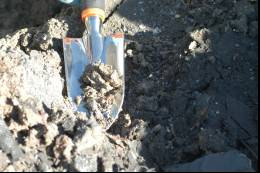
Figure 4: Hundreds of collector fragments were retrieved from the UTTR soil below the impact.
The collector arrays suffered most severely from the impact. Although several large collector fragments were recovered in the field (Figure 3) and later from the canister in the cleanroom, the majority of the collectors were broken into multiple fragments (many < 5 mm x 5 mm). A limited number of these fragments remained attached to the array frame and thus could be identified unambiguously. The majority of smaller fragments were contained in the canister lid by inverting it the canister in the field. These were transported to the cleanroom where they could be recovered and documented. After removal of the canister from the site, contingency team members spent two days searching the soil below, using tweezers and trowels to retrieve hundreds to thousands of collectors fragments. (Figure 4) Every effort was made to catalog the field location of collector fragments. Detailed conditions and photos of individual collector materials are discussed elsewhere [2].
Contamination Concerns:
All of materials within the canister were exposed to UTTR dust and soil as well as ablative byproducts and heatshield carbon. In addition, many of the silicon and germanium collectors were reduced to dust in the impact. This dust has coated the remaining collector fragments, complicating the dust and particulate removal process. The collectors employed on the Genesis arrays were polished only on the front side. This is advantageous in identifying the solar wind collection surface but allows dust to embed in the backside surface, making the samples more difficult to clean. It is important to remove this material since its composition is unknown and under the vacuum environment of many analysis techniques, seemingly welladhered dust may be liberated.
Conclusions:
Although the Genesis capsule did not experience a nominal reentry, every initial assessment performed to date indicates that science goals can be achieved. As a result of the development of a thoughtful contingency plan and detailed preliminary assessment plan before return, the mission and science teams are well prepared to provide the science community with useful and valuable solar wind samples.

